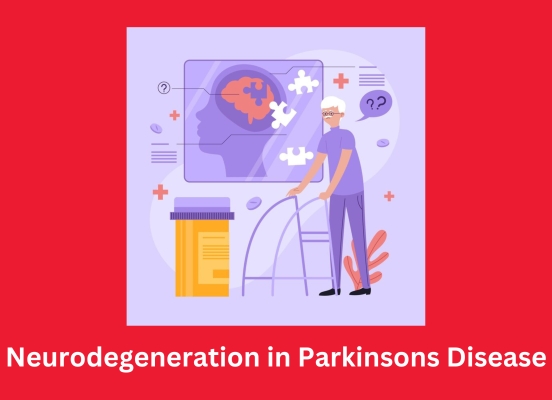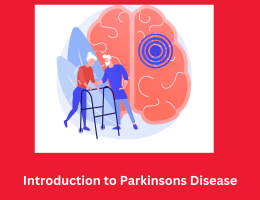
Neurodegeneration in Parkinsons Disease: Mechanisms and Pathways
- By admin --
- Wednesday, 13 Mar, 2024
Parkinson's disorder (PD) is a neurological contamination that worsens with time and is typified by means of the loss of life of dopamine-generating mind neurons. Determining the procedures and pathways that underlie the neurodegeneration in Parkinson's disorder (PD) is important to developing interventions and healing procedures that efficiently lessen or prevent the infection's improvement.
Alpha-synuclein-primarily based Lewy our bodies, aberrant protein aggregates, are one of the foremost medical features of Parkinson's ailment. These aggregates originate inside neurons. These Lewy bodies purpose disruptions to ordinary cell procedures and play a function in the malfunction and death of neurons. Nevertheless, the appropriate procedures in the back of the improvement of Lewy bodies and the following neurodegeneration are complicated and varied.
Parkinson's disorder aetiology has been linked to some of hereditary and environmental variables. Family versions of Parkinson's disease (PD) were related to mutations in genes together with SNCA (encoding alpha-synuclein), LRRK2, PARKIN, PINK1, and DJ-1. These links have supplied insights into the underlying molecular mechanisms involved inside the begin and direction of the contamination. Furthermore, a better incidence of Parkinson's illness has been linked to exposure to environmental pollution inclusive of insecticides and heavy metals, which will increase the opportunity that oxidative pressure and mitochondrial disorder play a position in neurodegeneration.
One of the primary reasons of the neuronal harm in Parkinson's disorder is oxidative pressure. Reactive oxygen species (ROS) can be produced due to dopamine metabolism, mitochondrial malfunction, and infection. ROS can oxidatively harm cell parts such proteins, lipids, and DNA. Over time, cellular antioxidant defences may be overwhelmed by oxidative damage accumulation, that could bring about neuronal malfunction and dying.
An in addition essential issue in the aetiology of Parkinson's ailment is mitochondrial dysfunction. The synthesis of energy (as adenosine triphosphate, or ATP) and manage over mobile metabolism are finished by way of mitochondria. The aetiology of Parkinson's ailment (PD) has been connected to dysfunction in mitochondrial bioenergetics, compromised mitochondrial dynamics, and defective mitophagy (the system by way of which broken mitochondria are selectively destroyed). In addition to inflicting strength shortages and extended oxidative stress, mitochondrial malfunction additionally affects calcium homeostasis and initiates pathways leading to apoptotic cellular death.
Infection also plays a crucial role in the neurodegenerative process of Parkinson's disease. The resident immune cells, known as microglia, of the crucial anxious apparatus become activated. Reactive oxygen species and pro-inflammatory cytokines are produced as a result, harming and killing neurons.
Prolonged neuroinflammation hastens the direction of the sickness through stressful neurodegeneration and maintaining the loop of immune activation and neuronal damage.
Furthermore, the aetiology of Parkinson's disorder is linked to disturbance of protein homeostasis, or proteostasis. The number one constituent of Lewy our bodies, alpha-synuclein, misfolds and aggregates, frightening the structures that regulate the pleasant of proteins inside cells. Toxic protein aggregates building up as a result of disrupted protein degradation mechanisms, together with the autophagy-lysosomal and ubiquitin-proteasome systems, which in the long run result in neuronal malfunction and death.
Excitotoxicity is every other pathophysiological system related to Parkinson's ailment. It is characterized by using excessive glutamate receptor activation and consequent calcium influx. Neuronal excitotoxicity, mitochondrial malfunction, and oxidative pressure can be added on by using calcium extra, which could bring about neuronal damage and demise. Dopamine-producing neurons of the substantia nigra pars compacta can be mainly prone because of dysregulation of glutamatergic neurotransmission and excitotoxicity.
In conclusion, oxidative strain, mitochondrial disorder, irritation, proteostasis dysregulation, excitotoxicity, and alpha-synuclein pathology are a number of the difficult and interrelated approaches that result in neurodegeneration in Parkinson's sickness. To maintain neuronal feature and limit the direction of Parkinson's disorder, specific medicines have to be evolved, which requires an know-how of those processes and pathways. To fully apprehend the molecular tactics behind neurodegeneration and to find new healing objectives for the management of this crippling ailment, more investigation is needed.





